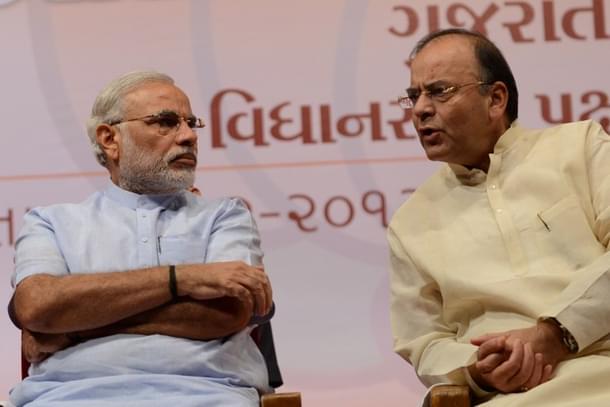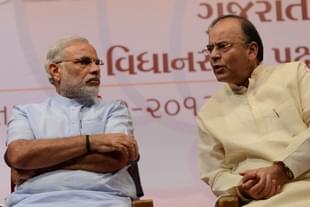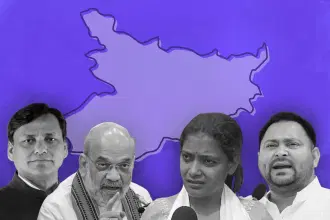Economy
IMF Paper: Modinomics, Not Cheap Oil, Is Behind Sharp Fall In Inflation
Arihant Pawariya
Aug 17, 2016, 02:55 PM | Updated 02:55 PM IST
Save & read from anywhere!
Bookmark stories for easy access on any device or the Swarajya app.


In an International Monetary Fund (IMF) working paper, economists Sajjid Chinoy, Pankaj Kumar and Prachi Mishra have come up with empirical findings which bust the notion that falling global crude oil prices alone are the reason for India’s disinflation.
Inflation, till its recent resurgence due to rising food prices, had dropped by more than half over two years, but the current NDA government hasn’t been appreciated enough for this significant achievement.
Consider these figures:
Consumer Price Inflation (CPI) had averaged more than nine percent between 2006 and 2013. The same figure for the years between 2000 and 2006 was four percent. India’s currency was in a downward spiral, with people opting for hard currency (gold) rather than the paper one. Macroeconomic stability had gone for a toss.
As the paper notes, after peaking at 12.1 percent year-on-year in November 2013, headline CPI
inflation collapsed to 4.3 percent in December 2014, and has hovered around five percent since then, barring the last few months. CPI inflation is expected to start cooling off following the good monsoons this year.
The fall in inflation is a feat worth appreciating given that high food inflation has persisted, driven by two back-to-back droughts. But critics brush this aside and attribute disinflation to global factors, especially the massive fall in crude oil prices in the international market.
However, the IMF paper has laid out a number of factors that are behind Indian disinflation and quantified the contribution of each factor using the Philips curve. Economic jargon is beyond the scope of this article, and those interested in methodology are advised to read the paper in original.
The tables below jot down the contribution of various factors to India’s sharp fall in inflation:
As the tables above show, close to half of the disinflation (46 percent and 52 percent in Tables 1 and 2 respectively) can be attributed to a moderation in the historical dynamics of inflation, which influences contemporaneous inflation.
The economists interpret lagged inflation to substitute adaptive inflation expectations. According to them, lags of inflation could also capture other institutional mechanisms like Minimum Support Price (MSP) setting and wage indexation, which generally propagate the persistence of inflation in India.
For instance, MSP inflation is an influential factor in shaping food, and in turn, headline inflation. And unlike wages, the effect of MSP inflation in headline inflation doesn’t become insignificant once past inflation is taken into account.
The IMF economists found that a one-percentage-point increase in MSP growth is associated with a six bps (100 bps make 1 percent) increase in headline CPI inflation. Some lags of global food prices can also influence the MSP setting process.
The second biggest contributor in bringing down inflation during 2013-2014, ‘New Regime dummy’ reduces headline CPI, on average, by 143 bps. The dummy represents forward-looking expectations. The economists say that it could either be reflecting the effect of the introduction of the new monetary policy regime or could be capturing how forward-looking expectations may have been influenced by the dramatic collapse in oil prices that year.
Their findings suggest that overall inflation expectations – both backward- and forward-looking – are important determinants of inflation in India.
Contrary to conventional wisdom, global factors that include oil and food prices and exchange rates have had a very insignificant role in bringing down inflation in the past two years.
Take, for instance, crude oil, which the sceptics tout as a major factor behind sharp disinflation. According to the economists, a one-percentage-point increase in global crude prices results in just a one bps increase in headline CPI.
And a one-percentage-point appreciation of the rupee against the US dollar is associated with a
reduction in the inflation rate by eight bps.
No wonder then that their contribution comes out as paltry (see both tables above). Though their share rose from 10 percent in Table 1 to 42 percent in Table 2, this still explains less than half the disinflation.
Note that the contribution of global crude oil to disinflation rose from two percent to 11 percent in the two time periods that the economists have considered.
Now the question arises, why didn’t the fall in crude oil prices have any large impact?
This is because the government didn’t pass on the benefits of the price fall to consumers. The economists note that between 1 October 2014 and 15 March 2016, crude oil prices fell 56 percent, but retail prices of gasoline and high-speed diesel only fell 13 percent and 21 percent respectively.
One hopes that after seeing the ample proof presented by Sajjid Chinoy, et al, in their paper, the critics would stop reasoning that the direct role of lower fuel prices is behind the sharp disinflation in India.
As meticulously elucidated in their paper, a moderation of expectations, both backward and forward, and a rationalisation of MSPs explain the bulk of the disinflation over the last two years.
And the present NDA government deserves credit for adopting economic policies that led us to where we are today.
Read the complete paper on the IMF website here.
Arihant Pawariya is Senior Editor, Swarajya.





